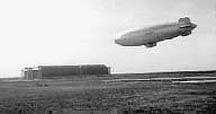
Lakehurst Naval Air Station (Naval Air Technical Training Center) presently occupies 7,400 acres of flat lowlands just north of Lakehurst, New Jersey. Commissioned in 1921, Lakehurst Naval Air Station, became the hub of naval lighter-than-air activity. Interest in airships in the United States began early in the 20th century. The first practical craft was the California Arrow, built by Thomas S. Baldwin in 1904. The U.S. Army purchased the first Federal airship from Baldwin five years later. Germany was the pioneer in the manufacture of rigid airships--airships that had the gas containers enclosed within compartments of a fixed fabric-covered framework--and during World War I maintained a fleet of Zeppelins, which it used primarily for patrolling and secondarily for bombing missions. The success of these airships prompted interest in the United States to develop them for coastal patrol to detect enemy submarines and mines and as a scouting arm for naval fleets. In 1921 the Navy established Lakehurst Naval Air Station to serve as its headquarters for lighter-than-air flight. The new base became the center for experimentation and development of rigid airships for strategic and commercial purposes as well as the control station for all Naval lighter-than-air flights.
The first major facility at Lakehurst was Hangar No. 1, a gigantic structure built in 1921 to house the huge helium-filled dirigibles. Hangar No. 1 measures 961 feet long, 350 feet wide and 200 feet high. At each end are two pairs of massive steel doors, mounted on railroad tracks. These double doors are structurally separate from the hangar itself. Each door weighs 1350 tons and is powered by two 20 horsepower motors, although provisions were made to open the doors manually, which required the assembled manpower of nine men. Inside it, Naval engineers assembled the first American-built rigid airship, the Shenandoah. On September 4, 1923, the ship made its maiden flight from Lakehurst. The Navy obtained its second rigid airship in 1924. Built in Germany and delivered to the United States as a war reparation payment, the Los Angeles shared Hangar No. 1 with the Shenandoah. The Navy used the dirigible extensively for experimental work on flight and mooring problems--it was the first American-owned airship developed to catch and release airplanes in flight. Lakehurst was also the home port for the Akron and theMacon. In addition to Hangar No. 1 there were five other hangars in two clusters, which have all since been converted for training and testing activities at the Naval Air Station. Hangar Nos. 2 and 3 housed blimps, Hangar No. 4 housed balloons and Hangars Nos. 5 and 6 housed either rigid air ships or blimps. The area between the two clusters of hangars was formerly used for mooring the airships and maneuvering them into the hangars.

During the late 1920s, Lakehurst became internationally known as a port for commercial lighter-than-air flight. It was the only stopping place in the United States for German airships, and in 1929 it played host to the Graf Zeppelin, then in the process of making the first round-the-world trip. However, of the five rigid airships eventually owned by the United States after World War I, all but one--the German-built Los Angeles--crashed, and many federal officials were skeptical of the desirability of continuing the program. Nevertheless, the Navy and the general public still supported the venture, largely because of the success of the German Zeppelins. A change in public opinion occurred in 1937, when the German Zeppelin Hindenburg, the largest airship ever built, burst into flames at Lakehurst. Thirty-six passengers died and the crash of the Hindenburg marked the end of commercial airship travel and the end of experimentation with hydrogen as a lifting device.
With the onset of World War II, lighter-then-air activity increased at Lakehurst, as the Navy increased its number of non-rigid airships (from six to 125). Lakehurst became the headquarters of the Chief of Naval Airship Training and Experimentation and also of the Commander Fleet Airships, Atlantic. During World War II, the Navy used blimps for observational purposes and they played an important role in escorting coastal convoys and in protecting American ships from submarine attack. With the end of the war, naval airship activity decreased, only to be expanded upon at the outbreak of the Korean War and then reduced again. In 1961 the Navy halted all lighter-than-air activity and ordered the blimps deflated and stowed.
Visit the National Park Service Travel American Aviation to learn more about Aviation related Historic Sites
Last updated: September 3, 2017
